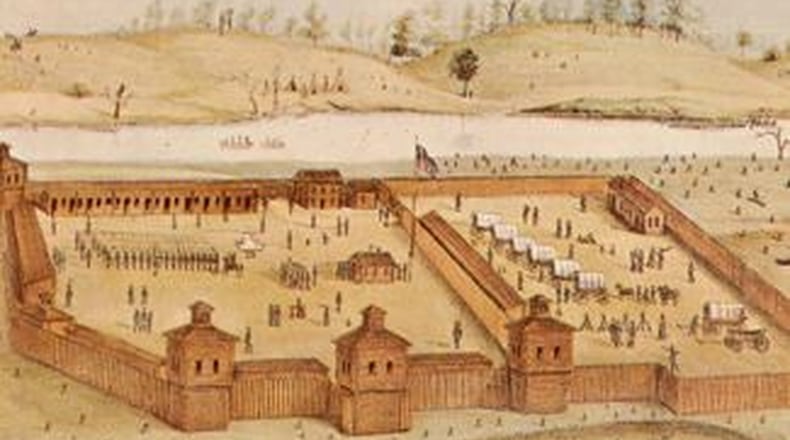According to her history, the Miami Tribe included the first Native-Americans encountered by European Americans in the Ohio area, and their primary place of residence was Pickawillany, near today’s Piqua. Chief Little Turtle was their most famous leader.
The Shawnee Tribe, led by chief Blue Jacket, banded together with the Miami Tribe and its chief, Little Turtle, in an effort to keep their homeland. The United States built a series of forts, extending northward from Fort Washington near the Ohio River in what now is Cincinnati toward current-day Toledo, including Fort Hamilton, Fort St. Clair, Fort Jefferson, Fort Recovery, Fort Adams, Fort Wayne, and Fort Defiance.
Some 2,300 troops (only 600 of them regulars) had left Fort Hamilton on Oct. 4, 1791, shortly after it was finished, and about 80 miles north of the fort were attacked at sunrise on Nov. 4 by 1,200 from the Miami, Shawnee, Wyandot, Ottawa, Chippewa, Delaware and Potawatomie, led by Little Turtle and Blue Jacket. Of those troops, 593 soldiers and 37 officers were killed, including Gen. Richard Butler, the namesake of Butler County, Creighton found in her research.
Meanwhile, “the Indians lost between 50-150 braves,” she found. “Nearly 300 men returned to Fort Jefferson wounded. It was the worst defeat the U.S. Army ever suffered at the hands of the Indians.”
In August of 1794, the Battle of Fallen Timbers happened, and Gen. “Mad” Anthony Wayne’s troops defeated Little Turtle and Blue Jacket. Fort Hamilton was closed in 1796 and was sold at auction.
After the fort was abandoned, its powder magazine became the county’s first courthouse, and the bell that was rung for celebrations of victories — or when enemies were spotted — was moved to the courthouse. That first courthouse building was destroyed by the Flood of 1913.
After Ohio gained statehood, its population ballooned from 45,365 in 1800 to 230,760 in 1810; followed by 581,434 in 1820; and 937,903 in 1830, according to census figures. Today’s estimated population is 11.7 million.
Ohio geography, as reflected by its largest cities, was very different from today, with cities that are medium-sized now being among of the largest.
According to U.S. Census numbers shared by the Ohio History Connection, Butler County during the first census of Ohio in 1810 was the fifth largest, with 11,150 people. The largest counties, in order, were Jefferson County (home of Steubenville), with 17,260 people; Ross County (Chillicothe), 15,258; Hamilton County (Cincinnati), 15,258; and Fairfield County (Lancaster), 11,361.
Notably missing from that list, from today’s perspective, were Franklin County, home to Columbus, with 3,486 people, and Cuyahoga (Cleveland), with 1,459 citizens.
Also not on that list of counties larger than Butler were Muskingum County, home of Zanesville, which was the state’s second capital from 1810-1812. It had 10,036 residents.
Facts about Ohio Statehood and Butler County History
Things you may not have known about Ohio and Butler County history:
- The plat for Hamilton was officially recorded on April 28, 1802, in Cincinnati because Hamilton at the time was part of Hamilton County.
- Hamilton was incorporated in 1810 with 242 people, but when a town is built on the site of a fort (Fort Hamilton), it is allowed to use the fort's completion date as its founding date, the reason Hamilton claims 1791 as its date.
- Hamilton originally was called Fairfield, which is ironic, because when today's Fairfield was incorporated in 1955, part of the reason residents made that decision was because they didn't want to be annexed by Hamilton.
- Ohio is called "the Buckeye State" partly because many buckeye trees used to cover the state's hills and plains. Buckeye comes from the Native American name "hetuck," for the fact the nuts resembled deers' eyes.
- The state motto is "With God All Things are Possible."
- The word Ohio comes from the Iroquis word for "good river," the name for the Ohio River.
- Other state symbols include the state amphibian (spotted salamander); beverage (tomato juice); bird (northern cardinal); flower (red carnation); fossil (isotelus trilobite); frog (bullfrog); fruit (tomato); gemstone (Ohio flint); insect (ladybug); mammal (white-tailed deer); native fruit (PawPaw); reptile (black racer, named at the request of Xenia school children); Rock song (Hang on Sloopy); state tree (Ohio Buckeye); and wildflower (white Trillium).
Source: Kathy Creighton, Butler County Historical Society executive director, and Ohio History Connection, formerly the Ohio Historical Society.
About the Author



